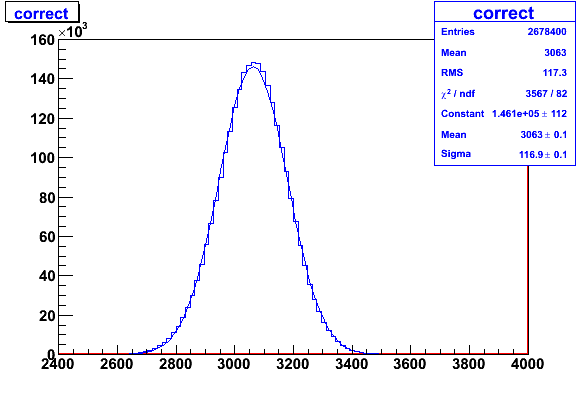I know it is root mean square.
For example a,b,c,d,e,f
RMS=sqrt((aa+bb+cc+dd+ee+ff)/6)
Is it right?
If you mean the RMS defined in an histogram, it is the standard deviation,
not the root mean square,
[quote=“moneta”]If you mean the RMS defined in an histogram, it is the standard deviation,
not the root mean square,
see root.cern.ch/root/html/TH1.html#TH1:GetRMS[/quote]
I find RMS in Users_Guide_5_12.pdf
see root.cern.ch/root/doc/RootDoc.html
page 57.Statistics Display:
the root mean square (RMS)
IS it right?
could you tell me all the meaning of “the 7 statistic display” in my plot?
thanks!
i fit the histogramm with gaus

As I said before, the meaning of RMS is standard deviation. This is common in physics, as it is mentioned also in
mathworld.wolfram.com/Root-Mean-Square.html
I agree, we should indicate that clearly also in the User guide.
Concerning the picture:
Mean: Average of the histogram entries
RMS: Standard deviation of the histogram entries
Chi2: Chi2 value obtained from the fit :
Sum squares of the normalized residuals :
Sum [( bin content - function value)/binError]^2
ndf : number of degree of freedom in the fit =
number of bins used in calculating the chi2 - number of fit parameters
then we have the fitted parameters :
Constant: is the amplitude of the fitted Gaussian function
Mean : is the mean of the gaussian
sigma: standard deviation of the gaussian
In case of perfect gaussian data and infinite statistics RMS -> sigma
I hope it is clear,
Regards,
Lorenzo
[quote=“moneta”]As I said before, the meaning of RMS is standard deviation. This is common in physics, as it is mentioned also in
mathworld.wolfram.com/Root-Mean-Square.html
I agree, we should indicate that clearly also in the User guide.
Concerning the picture:
Mean: Average of the histogram entries
RMS: Standard deviation of the histogram entries
Chi2: Chi2 value obtained from the fit :
Sum squares of the normalized residuals :
Sum [( bin content - function value)/binError]^2
ndf : number of degree of freedom in the fit =
number of bins used in calculating the chi2 - number of fit parameters
then we have the fitted parameters :
Constant: is the amplitude of the fitted Gaussian function
Mean : is the mean of the gaussian
sigma: standard deviation of the gaussian
In case of perfect gaussian data and infinite statistics RMS -> sigma
I hope it is clear,
Regards,
Lorenzo[/quote]
Yout are kind to me!
Thanks !
I am a student of China.And my professor did no know the meaning of RMS ,so i have to learn of them.So i tell him!
Wish you best!
Do you know Chinese?